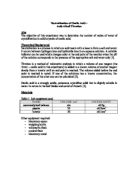Method
Accurately 1.5g of oxalic acid was weighed out and put in a 250cm3 volumetric flask. Then the water was added to make up the total volume of 250cm3.
Using a pipette 25.0cm3 of 0.100moldm-3 sodium hydroxide solution was placed in a conical flask and 2 drops of indicator – phenolphthalein – were added.
Prepared oxalic acid solution was run from a burette into the conical flask with the sodium hydroxide solution until the indicator lost its color. The procedure was repeated three times to get accurate results.
Subsequently, on the basis of collected data number of moles of water of crystallization in solid crystals of oxalic acid was calculated.
Data Collection
Quantitative Data
Table 3. Results of weighing.
Table 4. Titration results.
Qualitative Data
Table 5. Colors of the reactants and products.
Data Processing
The neutralization occurred when hydroxide ions present in the sodium hydroxide solution titrated reacted with the hydrogen ions present in the diotic acid. The reaction can be represented by the following equation:
or in simplified ionic form:
(The water of crystallization did not react, despite its presence in the solution)
To find the number of moles of NaOH that reacted we multiply the volume in dm3 by the concentration.
From the stoichiometry of the equation it is known that to neutralize 1 molecule of diethanoic acid, 2 molecules of NaOH were required. It meant that the number of moles of acid that reacted can be calculated as half of the number of moles of NaOH that reacted.
The average volume of the oxalic acid titrated from the three trials was calculated as an arithmetic mean of the volumes.
Hence, the average volume of the oxalic acid solution required for the neutralization of sodium hydroxide is 26.9cm3
Knowing the number of moles of the acid and the average volume of the acid titrated, the concentration of the acidic solution was calculated.
When the concentration of the acidic solution was known, the total number of moles of the acid in the initial solution was calculated as a product of the concentration and the volume of the initial solution - 250cm3.
From periodic table it is known that the molar mass of oxalic acid without the water of crystallization is 90.0gmol-1.
Hence, we can calculate the mass of oxalic acid present in the solution without water of crystallization.
At the beginning 1.5g of oxalic acid with water of crystallization were used. When we subtract the mass of acid without water of crystallization from the mass of the acid with water of crystallization we get the mass of water of crystallization.
The molar mass of water (from the periodic table) is 16gmol-1. We calculate the number of moles of water of crystallization in oxalic acid.
A ratio of the number of moles of the acid without water of crystallization to the number of moles of water of crystallization in oxalic acid:
Hence for one molecule of oxalic acid here are two molecules of water of crystallization. The formula can be now completed.
Table 6. Percentage Errors
Conclusion & Evaluation
The aim of this practical session was successfully achieved – the number of moles of water of crystallization was calculated. The result obtained is in accordance with the published data ż4śŁ oxalic acid is a dihydrate salt with a formula (COOH)2 · 2H20
Limitations
- the end point of the reaction was only observed with a naked eye
- the human reaction time when turning the tap of the burette decreased the accuracy of the volume titrated
- the residues if oxalic acid on the glassware (it is only slightly soluble in water) could affect the results
Errors
- the errors encountered in this practical session did not affect the outcome of the experiment very seriously, they were mainly rooted in the uncertainties of the measuring devices used (e.g. balance, burette, pipette, volumetric flask) – the percentage error was 3.5%
Suggestions for improvement
- the end point of the reaction could have been more precisely observed using a pH meter instead of indicator
- to decrease the uncertainty of the balance analytical one should be used instead of a semi-analytical one.
- in the future more trials should be carried out to minimize the possibility of random errors.
References
- “neutralisation” A Dictionary of Chemistry. Oxford University Press, 2000. Oxford Reference Online. 19 November 2006 <http://www.oxfordreference.com/views/ENTRY.html?subview=Main&entry=t81.e2842>
- “titration” A Dictionary of Chemistry. Oxford University Press, 2000. Oxford Reference Online. 19 November 2006 <http://www.oxfordreference.com/views/ENTRY.html?subview=Main&entry=t81.e4123>
- “oxalic acid” A Dictionary of Chemistry. Oxford University Press, 2000. Oxford Reference Online. 19 November 2006 <http://www.oxfordreference.com/views/ENTRY.html?subview=Main&entry=t81.e3028>
- “oxalic acid dehydrate” Odczynniki Chemiczne 2002 (Polish Edition), dr Wolfgang Baden, Merck KGaA, Darmstadt.







